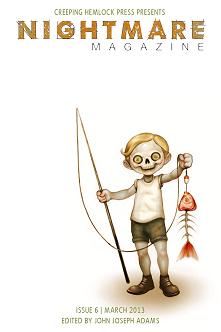 Nightmare #6, March 2013
Nightmare #6, March 2013
Reviewed by Colleen Chen
I keep thinking that I’m not a fan of reading horror, but then I come across stories like the two in this issue of Nightmare, and then I realize that it’s not horror I don’t like—it’s just badly written horror. Both of these stories are of the sort of quality and depth that would be appreciated by readers regardless of genre preferences.
“The Sign in the Moonlight” by David Tallerman is a Lovecraftian tale narrated by a member of a doomed mountaineering expedition in the Himalayas. It takes place in 1908, when Aleister Crowley’s ascent into the occult was still gaining momentum. The narrator agrees to attempt a climb of Mount Kangchenjunga, led by the finest mountaineer of his generation—even though an earlier team’s attempt led to a fatal failure in which rumors of occult sacrifice and Crowley involvement abounded.
When the new expedition arrives at the fifth camp, near the place where the other expedition failed, the narrator falls ill and stays behind. The rest of the team dies by avalanche, and the narrator stumbles through a storm to a strange monastery, innocuous save for a golden pentagram mounted upon it—a symbol with occult significance. Inside, he witnesses a terrifying ritual with all sorts of evil ramifications for humanity, and he realizes that the avalanche may not have been an accident after all.
This is a dark, compelling, creepy-good story with enough basis in reality that I actually thought it might be true, and I spent a good few minutes searching about it on the Internet. The narrator’s voice is impeccable—you get the impression of a man who’s been shaken to his core by what he’s seen. The element of horror in this piece is subtle but pervasive, and the use of Crowley, who is in himself rather scary, is clever. I enjoyed the read.
“No Breather in This World but Thee” by Jeff VanderMeer is an odd piece, one that feels just as much poem as story. In it, something is happening again, just like last year—but this time it’s worse. Inanimate objects come to life, people are eaten by shadows or ghosts or monsters or said inanimate objects, and heads are pulped or cut off or drained by towers birthed by giant monsters falling from the sky. As a sack of bloody flesh and bones crawls toward the river and a memory of love that exists there, a wormlike tower and a mansion newly come to life give battle.
Sound confusing? It is, if you’re looking for a clear plot. Even without one, though, the stream of dreamlike, shifting images of this piece have an internal consistency that allow the reader to see a story beyond the series of discrete and often bloody events. It’s probably not the same story as another reader would see, but that seems to be intentional on the part of the author.
This bit, scribbled by one of the characters who ends up being eaten by his shadow, might shed some light: “Inklings are like questions that haven’t been answered yet: by the time we ask them, we’re being swallowed by the doors they open. And all that’s left at the end, after the question’s answered, is the shadow, haunting us.” This is what this story is like—the meaning flickers in one’s peripheral vision. It’s a beautiful, memorable piece, worth reading both for its well-executed concept and for its utterly gorgeous prose.